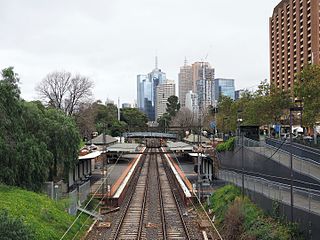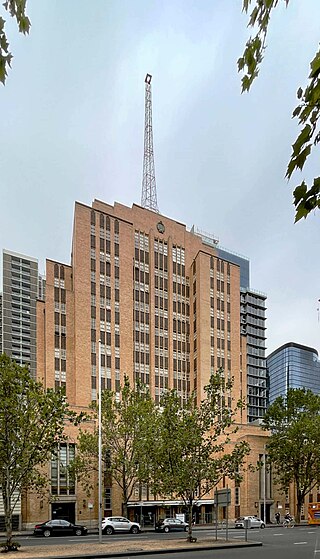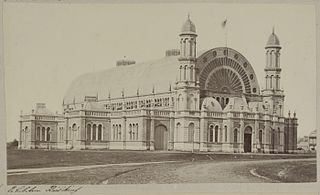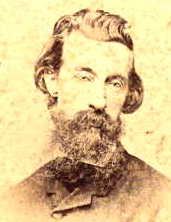
Jolimont railway station is located on the Mernda and Hurstbridge lines in Victoria, Australia. It serves the inner eastern Melbourne suburb of East Melbourne, and opened on 21 October 1901.

Charles la Trobe, CB, commonly Latrobe, was appointed in 1839 superintendent of the Port Phillip District of New South Wales and, after the establishment in 1851 of the colony of Victoria, he became its first lieutenant-governor.

The Queen Victoria Market is a major landmark in the central business district (CBD) of Melbourne, Victoria, Australia. Covering over seven hectares, it is the largest open air market in the Southern Hemisphere.

East Melbourne is an inner-city suburb in Melbourne, Victoria, Australia, 2 km (1.2 mi) east of Melbourne's Central Business District, located within the City of Melbourne local government area. East Melbourne recorded a population of 4,896 at the 2021 census.

La Trobe Street is a major street and thoroughfare in the city centre of Melbourne, Victoria, Australia. It runs roughly east–west and forms the northern boundary of Melbourne's central business district. The street was laid out as an extension of the original Hoddle Grid in 1839 and was named after Charles La Trobe. La Trobe Street extends from Victoria Street in the east to Harbour Esplanade in the west.

The Argus was an Australian daily morning newspaper in Melbourne from 2 June 1846 to 19 January 1957, and was considered to be the general Australian newspaper of record for this period. Widely known as a conservative newspaper for most of its history, it adopted a left-leaning approach from 1949. The Argus's main competitor was David Syme's more liberal-minded newspaper, The Age.

Government House is the official residence of the governor of Victoria, currently Linda Dessau. It is located in Kings Domain, Melbourne, next to the Royal Botanic Gardens.

Cooks' Cottage, previously known as Captain Cook's Cottage, is located in the Fitzroy Gardens, Melbourne, Australia. The cottage was constructed in 1755 in the English village of Great Ayton, North Yorkshire, by the parents of Captain James Cook, James and Grace Cook, and was brought to Melbourne in 1934 by Sir Russell Grimwade. It is a point of conjecture among historians whether James Cook, the famous navigator, ever lived in the house, but almost certainly he visited his parents at the house.

Russell Street Police Headquarters was located on the north-eastern corner of Russell and La Trobe Streets, Melbourne was the headquarters of the Victoria Police through the second half of the 20th century.

Young and Jackson is a hotel in Melbourne, Victoria, Australia, at the corner of Flinders Street and Swanston Street. Established in 1861, it is listed on the Victorian Heritage Register.

Coop's Shot Tower is a shot tower located in the heart of the Melbourne CBD, Australia. It was completed in 1889 and is 50 metres high. The historic building was saved from demolition in 1973 and was incorporated into Melbourne Central complex in 1991 underneath an 84 m-high conical glass roof.

The Athenaeum or Melbourne Athenaeum is an art and cultural hub in the central business district of Melbourne, Victoria, Australia. Founded in 1839, it is the city's oldest cultural institution.

The first Sydney Intercolonial Exhibition was a series of exhibitions inspired by the historic Great Exhibition held in London in 1851. The Colony of New South Wales mounted its first such exhibition in 1854 in preparation for the Paris Exhibition of 1855, another in 1861 in preparation for the London Exhibition of 1862, and then several more until being held annually throughout the 1870s under the name Metropolitan Intercolonial Exhibition.

Princes Bridge, originally Prince's Bridge, is a bridge in central Melbourne, Australia that spans the Yarra River. It is built on the site of one of the oldest river crossings in the city, and forms a gateway into the central city from the south. The bridge connects Swanston Street on the north bank of the Yarra River to St Kilda Road on the south bank, and carries road, tram and pedestrian traffic. The present bridge was built in 1888 and is listed on the Victorian Heritage Register.

North Melbourne Town Hall is the former town hall of the Town of North Melbourne in Victoria, Australia. It was listed on the former Register of the National Estate on 21 March 1978 and on the Victorian Heritage Register on 11 March 2010.
The Eastern Market, also known as 'Paddys Market', was one of the three markets established in Melbourne, Victoria, Australia in the 1840s. It operated from 1847 until the demolition of its buildings in 1960.

Edward La Trobe Bateman was a Victorian painter in watercolour, architect, book illustrator, draughtsman and garden designer. He worked in Australia from 1852 to 1869, and had links with the Pre-Raphaelite Brotherhood.
The Melbourne City campus of the Royal Melbourne Institute of Technology is located in the city centre of Melbourne in Victoria, Australia. It is sometimes referred to as "RMIT City" and the "RMIT Quarter" of the city in the media.
Albert Purchas was a prominent 19th century architect and surveyor in Melbourne, Australia.
The Lieutenant-Governor of Victoria is a government position in the state of Victoria, Australia, acting as a deputy to the Governor of Victoria. When the governor is out of the state, the lieutenant-governor acts as the governor. This office has often been held concurrently by the Chief Justice of Victoria.




















